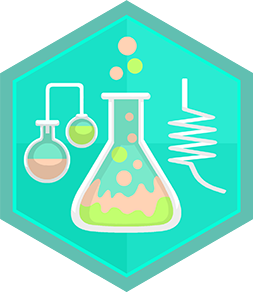Experiment with explosion variables
Make and test safe baking soda volcanoes using vinegar, with adult supervision, changing ingredient amounts and container shapes to study eruption size and height.



Step-by-step guide to experiment with explosion variables
Step 1
Put on your safety goggles.
Step 2
Ask an adult to stay with you while you do the experiment.
Step 3
Place a tray or baking sheet on a flat surface to catch spills.
Step 4
Put your first container on the tray.
Step 5
Measure and pour 1/2 cup (120 mL) vinegar into the container.
Step 6
Measure 1 teaspoon (5 mL) baking soda into a spoon.
Step 7
Quickly pour the baking soda into the container.
Step 8
Step back and watch the eruption happen.
Step 9
Write the eruption height and what you observed in your notebook.
Step 10
Wipe up the mess and dry the container and tray with paper towels.
Step 11
Choose one variable to change for the next test such as using more baking soda or a different shaped container.
Step 12
Make only that single change now (for example use 2 teaspoons baking soda or swap in a different container).
Step 13
Repeat the same steps you did before with your changed variable and write the new eruption height and notes in your notebook.
Step 14
Share your finished creation and what you learned on DIY.org.
Final steps
You're almost there! Complete all the steps, bring your creation to life, post it, and conquer the challenge!


Help!?
What can I use if I don't have safety goggles, a tray, or exact measuring tools?
If you don't have safety goggles use snug safety glasses or ask the adult to provide them, if you lack a tray use a large shallow baking dish or cookie sheet to catch spills, and measure 1/2 cup (120 mL) and 1 teaspoon (5 mL) with kitchen measuring spoons or a marked drinking cup.
The eruption was tiny—what might I be doing wrong and how can I fix it?
Check that you actually poured 1/2 cup (120 mL) vinegar into the container and then quickly added dry 1 teaspoon (5 mL) baking soda, and if the blast is still small try using drier baking soda, a narrower container, or increasing to 2 teaspoons baking soda as suggested in the instructions to raise the eruption height.
How can I adapt this experiment for different ages?
For younger kids have an adult pre-measure and pour the 1/2 cup vinegar and 1 teaspoon baking soda or use smaller amounts like 1/4 cup vinegar and 1/2 teaspoon baking soda with close supervision, while older kids can change one variable (e.g., swap in a different shaped container or use 2 teaspoons baking soda), precisely record eruption height in the notebook, and analyze results.
What are some fun ways to extend or personalize the experiment?
Add food coloring to the vinegar, build a papier-mâché volcano around your container, test variables like container shape or vinegar temperature and record eruption heights in your notebook, then share photos or videos of the results on DIY.org.
Watch videos on how to experiment with explosion variables
Scientific Method: Paper Towel Experiment
Facts about chemistry experiments for kids
♻️ Baking soda and vinegar are non-toxic and biodegradable, so the experiment is easy to clean up with adult help.
⚖️ Eruption size depends on amounts and ratio — adding more baking soda or more vinegar can make bigger fizz, but the best fizz needs the right mix.
📏 A tall, narrow bottle often shoots foam higher than a short, wide bowl, so container shape changes eruption height.
🧪 Mixing baking soda and vinegar produces carbon dioxide gas — that fizz is what pushes the "lava" out!
🌋 Some real volcano eruptions can send ash and gas over 20 km high — your model shows the same idea on a tiny, safe scale.
How do I run a baking soda and vinegar volcano experiment to test eruption variables?
What materials do I need for a baking soda volcano experiment?
What ages is the baking soda volcano activity suitable for?
Is the baking soda volcano experiment safe and what safety rules should I follow?


One subscription, many ways to play and learn.
Only $6.99 after trial. No credit card required



